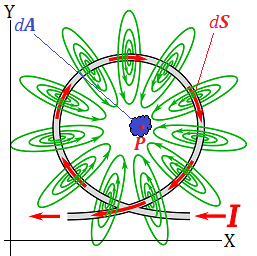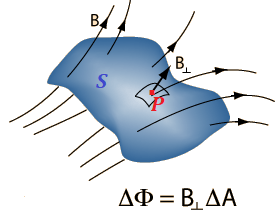Notes to a video lecture on http://www.unizor.com
Magnetic Flux
Consider a flat lying completely within an XY-coordinate plane closed
wire loop that includes a battery with direct electric current I running through it.

Since electric current generates a magnetic field around each however small segment of a wire dS
with circular magnetic field lines around it in the plane perpendicular
to this segment of a wire, the general direction of all magnetic lines
inside a wire loop will be parallel to Z-axis.
More precisely, vectors of magnetic field intensity B at
all points of XY-plane inside a wire loop are similarly directed
perpendicularly to this plane and parallel to Z-axis. They are not
necessarily equal in magnitude, though.
Consider an infinitesimal two-dimensional area of XY-plane inside a wire loop dA around some point P.
Since it's infinitesimal, we can assume that the intensity of the
magnetic field inside it is uniform and equal to the intensity at point P, which we will denote as vector B(P).
This intensity is a result of combined magnetic field generated at that point by all infinitesimal segments dS of a wire.
Each one of these components of a resulting intensity vector has a
direction perpendicular to a direction of electric current in segment dS (its source) and to a vector R from a chosen infinitesimal segment dS of a wire loop to point P, from which follows the perpendicularity of all vectors of magnetic field intensity to XY-plane and parallel to Z-axis.
Magnetic field, as other force fields, is additive, that is, the
combined intensity vector generated by an entire wire loop is a vector
sum of intensity vectors generated by each segment of a wire.
All these individual magnetic fields generated by different segments of a
wire are directed along the Z-axis, so we will concentrate only on
their magnitude to find the result of their addition.
Knowing the geometry of a wire and the electric current I in it, we can use the law we described in the previous lecture that determines the magnetic field intensity at any point P inside a wire loop generated by its any infinitesimal segment dS:
dB = μ0·I·dS·sin(α) / (4πR²)
where
R is a magnitude of a vector R from a chosen infinitesimal segment dS of a wire loop to point P,
dS is the infinitesimal segment of a wire,
α is an angle between the direction of electric current in the segment dS and a vector R from this segment to a point P,
μ0 is the permeability of free space.
Integrating this along the entire wire (this is integration along a curve) gives the value of magnetic field intensity B(P) at point P.
Now we assume that this process is done and function B(P) is determined, that is we know the magnitude B(P) of the intensity vector of magnetic field generated by our wire loop at any point P inside a loop.
Recall that the direction of this vector is always along Z-axis, that is perpendicular to a plane of a wire loop.
We define magnetic field flux Φ as a two-dimensional integral of a product of intensity B(P) by area dA.
In a simple case of a constant magnetic field intensity B(P)=B at any point P inside a loop this is a simple product of a constant magnetic field intensity B by the area of a wire loop A
Φ = B · A
If B(P) is variable inside a loop, the two-dimensional integration by area of the loop produces the magnetic field flux
Φ = ∫∫AB(P)·dA
The complexity of exact calculation of magnetic field intensity B(P) at any point P inside a loop and subsequent calculation of the magnetic field flux
flowing through the wire loop are beyond the scope of this course, so
in our practice problems we will usually assume the uniformity of the
magnetic field with constant B(P)=B.
A concept of magnetic field flux is applicable not only for a
magnetic field generated by a wire loop with electric current running
through it. It is a general concept used to characterize the combined
effect of a magnetic field onto the area where we observe it.
Consider an analogy:
magnetic field intensity and amount of grass growing in the backyard in a season per unit of area,
wire loop area and area of a backyard,
magnetic field flux and how much grass growth in an entire backyard in a season.
Another analogy:
magnetic field intensity and productivity of each individual doing some work,
wire loop area and a team of people doing this work,
magnetic field flux and productivity of a team doing this work.
A general magnetic field flux is defined for a given magnetic field with known intensity vector B(P) at each point P of space and given two-dimensional finite surface S in space, through which magnetic field lines are going.

The purpose of our definition of magnetic field flux in this general case is to quantify the total amount of "magnetic field energy" flowing through a surface S.
Notice a small area around point P on a picture above.
If we consider it to be infinitesimally small, we can assume that
magnetic field intensity at any point of this small area is the same as
at point P.
If this small area is perpendicular to vector B(P), we would just multiply the magnitude of intensity vector B(P) in tesla by the area ΔA of a small area around point P in square meters and obtain the magnetic field flux ΔΦ going through this small area in units of magnetic flux -
weber = tesla · meter².
In a more general case, when this small area around point P is not perpendicular to magnetic field intensity vector B(P), to obtain the magnetic field flux going through it, we have to multiply it by cos(φ), where φ(P) is an angle between magnetic field intensity vector B(P) and normal (perpendicular vector) to a surface at point P.
So, the expression for an infinitesimal magnetic field flux around point P is
dΦ = B(P)·cos(φ(P))·dA
The unit of measurement of magnetic field flux is Weber (Wb) that is equal to a flux of a magnetic field of intensity through an area of
1 Wb = 1 T · 1 m²
Once we have determined the magnetic field flux flowing through a
small area around each point of a surface, we just have to summarize
all these individual amounts to obtain the total magnetic field flux flowing through an entire surface.
Mathematically, it means we have to integrate the above expression for dΦ along a surface S.
We will not consider this most general case in this course. Our magnetic fields will be, mostly, uniform and surfaces flat.


No comments:
Post a Comment